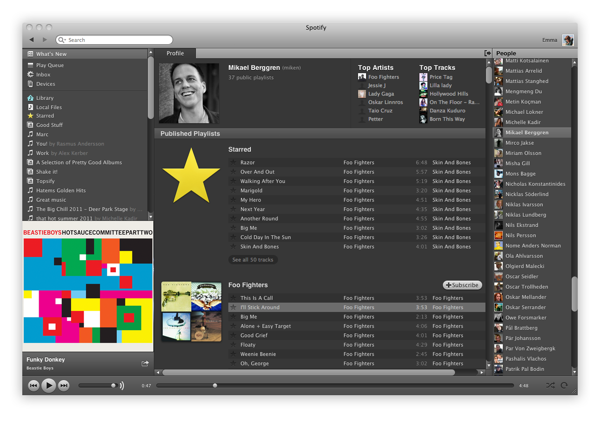If you’ve been paying any attention at all to the tech press recently, you know that Spotify, the cloud-based music service, finally launched in the U.S., though you have to have an invite in order to use it, currently.
This morning, I happened to open up my email as I usually do, and Spotify was kind enough to send me one. So I thought I’d report what the much-anticipated service is actually like.
Spotify’s biggest feature is its large music library. I was able to search for just about every piece of music I could imagine. The only thing I couldn’t find was The Beatles, or at least the real Beatles music instead of interviews and other questionable recordings. Given the long time it took for Apple Corps. to agree to get the Fab Four on iTunes, I’m not optimistic about them ending up on Spotify real soon, but there’s always iTunes, of course.
Speaking of iTunes, when I first launched Spotify, it found my iTunes library and imported it, including my playlists. But the music I’d purchased from the time when Apple still put DRM on their music couldn’t be played, for obvious though annoying reasons. But again, that’s a perfect reason to hang onto iTunes and my iPod.
Spotify’s layout is very similar to iTunes, though done in black instead of the metal styling on Apple’s program. Using it on the whole is very easy. You just search for what you want to hear, double-click, and it’s playing. The bit rate is a bit lower than a standard MP3 or AAC file, but it’s still quite listenable. If you sign up for the paid services, which I’ll get to, Spotify says you’ll get improved sound quality. The basic audio sounds about as good as a tabletop FM radio.
Some albums have tracks that are designed to immediately segue into another without a break. CDs and iTunes do this automatically, but on Spotify there’s an audible gap between some songs. Fans of Pink Floyd might find this a little annoying.
Spotify is free, but there are some paid upgrades as well. The Unlimited tier gets rid of the advertising and lets you play songs as much as you like, while Premium gets you access to the mobile app and lets you play your tracks offline.
One thing I wish was better would be improved discovery of songs. You can currently see what’s popular, but that’s pretty much it. Spotify is great, however, if you know exactly what you’re looking for. It looks like Pandora is safe in that regard.
That said, it looks like Spotify lives up to the buzz that’s surrounded it. With its large, always-on library, Spotify looks poised to dominate this new decade the way the iPod ruled the ’00s, the CD ruled the ’90s, and the Walkman ruled the 1980s.
While using this, I’m, in the words of Homer Simpson, a kid in some kind of store.
We covered a rumor (which obviously came true) that Spotify would launch in mid-July. We also covered Spotify officially crossing the Atlantic.











